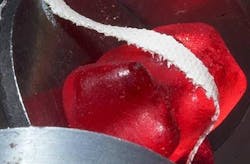Positronium photons characterize gummy bear nanopores
Gummy bears, as well as other forms of gelatin, are used in the pharmaceutical industry to encapsulate biologically active substances such as medication and vitamins, protecting against oxidation and overly quick release. Nanopores in gelatin have a significant influence on the material's porperties, yet they are difficult to investigate. Now, in experiments on gummy bears, researchers at Technische Universität München (TUM; Munich, Germany) have determined relevant gelatin properties using positron-annihilation-lifetime spectroscopy (PALS).1
In PALS, a beam of positrons is directed at the gummy bear or other subject; if a positron encounters an electron, the two particles briefly form an exotic atom-like object called positronium, then annihilate, producing two photons, each with a 0.511 MeV energy (occasionally, three photons of lower energy are produced instead).
Positronium lasts longer in wet gummy bears
The scientists positron-bombarded red gummy bears at various stages of bear wetness in order to model gelatin capsules dissolving in the stomach. Results of the photon measurements showed that positronium lasts an average of 1.2 ns in dry bears and 1.9 ns in saturated bears.
From these lifetimes, the scientists then deduced the number and size of nanopores in the material. Saturation, which increases a bear's volume by 2.5 times, also leads to formation of voids with an average size of 84.3 Å.
"The larger the free volume [of the nanopores], the easier it is for oxygen to penetrate it and harm the medication, but also the less brittle the gelatin," says Christoph Hugenschmidt, a physicist at TU München.
Source: http://www.tum.de/en/about-tum/news/press-releases/short/article/32047/
REFERENCE:
1. Christoph Hugenschmidt and Hubert Ceeh, Journal of Physical Chemistry B (2014); doi: 10.1021/jp504504p
About the Author
John Wallace
Senior Technical Editor (1998-2022)
John Wallace was with Laser Focus World for nearly 25 years, retiring in late June 2022. He obtained a bachelor's degree in mechanical engineering and physics at Rutgers University and a master's in optical engineering at the University of Rochester. Before becoming an editor, John worked as an engineer at RCA, Exxon, Eastman Kodak, and GCA Corporation.

